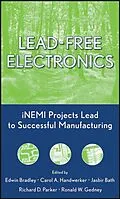Based on the results of a more than two-year study, Lead-Free
Electronics: iNEMI Projects Lead to Successful Manufacturing is
the first practical, primary reference to cover Pb-free solder
assembly as well as the analysis and reasoning behind the selection
of Sn-Ag-Cu as the recommended Pb-free replacement for Sn-Pb.
Reflecting the results of a two-year study, Lead-Free
Electronics: iNEMI Projects Lead to Successful Manufacturing
provides full coverage of the issues surrounding the implementation
of Pb-free solder into electronic board assembly. This book is
extremely timelyâ??most electronic manufacturers are going to
change over to Pb free soldering by 2006 to meet new European laws.
All manufacturers around the globe are going to be affected by this
change. The text provides specific results from the thirty company
NEMI project activities. It contains integrated and fully
documented book chapters with references to existing published work
in the area. These serve as tremendous resources for engineers and
companies faced with making the switch to Pb-free solder
assembly.
Autorentext
Edwin Bradley is a Distinguished Member of the Technical Staff with Motorola Advanced Product Technology Center in Plantation, Florida. He has extensive experience evaluating the materials, assembly processes, and reliability of portable electronic products, with an emphasis on lead-free soldering.
Carol A. Handwerker is Professor of Materials Engineering at Purdue University. She is active on the iNEMI Technical and Research Committees.
Jasbir Bath is Lead Process Engineer at Solectron Technical Centre in Milpitas, California. He has been chair of various iNEMI lead-free consortia groups.
Richard D. Parker has spent nearly forty years at Delphi Electronics & Safety in Kokomo, Indiana, and he has been active in iNEMI since its inception.
Ronald W. Gedney retired as vice president of operations at iNEMI and remains on as a consultant. A Fellow of the IEEE, he is also a past president of the IEEE Components, Packaging, and Manufacturing Technology (CPMT) Society.
Klappentext
A timely and practical treatment of implementation of lead-free solder in the manufacturing environment
In order to meet new laws in Europe, electronic manufacturers around the globe have had to change over to lead-free soldering. Now, Lead-Free Electronics is the first practical, primary reference to cover lead-free solder assembly, as well as the analysis and reasoning behind the selection of Sn-Ag-Cu as the recommended lead-free replacement for Sn-Pb.
Reflecting the results of a two-year study undertaken by a cross-section of some of the largest North American electronic equipment manufacturers, Lead-Free Electronics provides full coverage of the issues surrounding the implementation of lead-free solder into electric board assembly. Additionally, fully documented book chapters with references to existing published work in the area make this an invaluable reference for the countless engineers and companies faced with making the switch to lead-free electronics.
Zusammenfassung
Based on the results of a more than two-year study, Lead-Free Electronics: iNEMI Projects Lead to Successful Manufacturing is the first practical, primary reference to cover Pb-free solder assembly as well as the analysis and reasoning behind the selection of Sn-Ag-Cu as the recommended Pb-free replacement for Sn-Pb.
Reflecting the results of a two-year study, Lead-Free Electronics: iNEMI Projects Lead to Successful Manufacturing provides full coverage of the issues surrounding the implementation of Pb-free solder into electronic board assembly. This book is extremely timelyâ??most electronic manufacturers are going to change over to Pb free soldering by 2006 to meet new European laws. All manufacturers around the globe are going to be affected by this change. The text provides specific results from the thirty company NEMI project activities. It contains integrated and fully documented book chapters with references to existing published work in the area. These serve as tremendous resources for engineers and companies faced with making the switch to Pb-free solder assembly.
Inhalt
Preface (Ronald W. Gedney).
Contributors.
Introduction (Jasbir Bath and Carol A. Handwerker).
Lead-Free Assembly Project.
Alloy Group.
Process Group.
Component Group.
Reliability Group.
Follow-On Projects/Work.
1. Alloy Selection (Carol A. Handwerker, Ursula Kattner, Kilwon Moon, Jasbir Bath, Edwin Bradley, and Polina Snugovsky).
1.1. Introduction.
1.2. Lead-Free Alloys Considered by iNEMI in 1999 as Replacements for TinLead Eutectic Solder.
1.3. Fundamental Properties of Lead-Free Solder Alloys Affecting Manufacturing and Reliability.
1.4. R&D Issues Remaining in Lead-Free Solder Implementation.
1.5. Summary.
References.
2. Review and Analysis of Lead-Free Solder Material Properties (Jean-Paul Clech).
2.1. Introduction.
2.2. TinLead Properties and Models.
2.3. TinSilver Properties and Creep Data.
2.4. TinSilverCopper Properties and Creep Data.
2.5. Alloy Comparisons.
2.6. General Conclusions/Recommendations.
Appendix A: TinSilver Creep Data.
Appendix B: TinSilverCopper Creep Data.
Acknowledgments.
References.
3. Lead-Free Solder Paste Technology (Ning-Cheng Lee).
3.1. Introduction.
3.2. Materials.
3.3. Rheology.
3.4. Applications.
3.5. Reflow Soldering.
3.6. Microstructures of Reflowed Joints.
3.7. Challenges of Lead-Free Reflow Soldering.
3.8. Summary.
References.
4. Impact of Elevated Reflow Temperatures on Component Performance (Richard D. Parker, Jack MCCullen, Nick Lycoudes, and R. J. Arvikar).
4.1. Introduction to Component Lead-Free Issues.
4.2. Moisture/Reflow Impact on Packaged Integrated Circuits.
4.3. Impact of Increased Solder Peak Reflow Temperatures on Moisture Sensitivity Level Ratings.
4.4. Impact of Increased Solder Peak Reflow Temperatures.
4.5. Observations on Profiling for the Lead-Free Reflow Processes.
4.6. IC Package Improvement Options for Better Package MSL at Higher Lead-Free Solder Reflow Temperatures.
4.7. Frequency Control Products.
4.8. Lead-Free Cost Impact on Components.
4.9. Packaging Identification of Lead-free Packaged ICs.
4.10. Conclusions.
Acknowledgments.
References.
5. Lead-Free Assembly ReliabilityGeneral (Edwin Bradley).
5.1. Introduction.
5.2. Basic Physical Properties of Solder.
5.3. Creep Deformation.
5.4. Thermal Fatigue.
5.5. Creep Rupture.
5.6. Isothermal (Mechanical) Fatigue.
5.7. Out-of-Plane Bending.
5.8. Impact/Shock Loading.
5.9. Effect of Rework on Reliability.
5.10. High-Temperature Operating Life (HTOL).
5.11. Electrochemical Migration.
5.12. Tin Whiskering.
5.13. Tin Pest.
5.14. Summary.
Acknowledgments.
References.
6. Lead-Free Assembly Reliability: iNEMI Evaluation and Results (Elizabeth Benedetto and John Sohn).
6.1. Reliability Team Goals.
6.2. Reliability Test Matrix.
6.3. Component-Paste-Board Finish Combinations.
6.4. Components.
6.5. Test Vehicles.
6.6. Pre-Test/Post-Assembly Information.
6.7. CTE Determination: Component and Boards.
6.8. Thermal Cycling Conditions.
6.9. Failure Criteria.
6.10. Thermal Cycle Relative Performance.
6.11. Failur…
